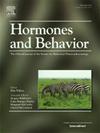人际感觉运动同步中的催产素动力学:人类对照实验
IF 2.4
3区 医学
Q2 BEHAVIORAL SCIENCES
引用次数: 0
摘要
人际感觉运动同步是个体之间运动的协调,是成功人际沟通的基础。先前的研究表明,催产素(OXT)可能参与了同步过程。我们进行了2个随机对照实验来测试同步对唾液OXT浓度的影响。在实验1中,90名志愿者(65名女性)与一个不熟悉的伙伴一起进行了5分钟的同步或非同步手势任务。在实验2中,67对熟悉的志愿者(47对女性)执行同样的任务。在手势任务之前和之后(实验1)或手势任务之前,之后和之后10分钟(实验2)测量唾液OXT浓度。使用ELISA法分析唾液样本以估计OXT浓度。在实验1中,我们发现在同步或异步条件下,基线和5分钟任务后的唾液OXT水平没有显著差异。我们也没有发现在感觉运动同步后对陌生人的好感会增加的证据。在实验2中,异步条件导致OXT水平随着时间的推移而下降,而同步交互导致OXT水平随着时间的推移而稳定。亲密程度和依恋类型不影响条件对应激反应的影响。研究结果与研究人际同步性的研究方法有关。本文章由计算机程序翻译,如有差异,请以英文原文为准。
Oxytocin dynamics in interpersonal sensorimotor synchrony: Controlled experiments in humans
Interpersonal sensorimotor synchronisation is the coordination of movement between individuals that underlies successful interpersonal communication. Previous research has indicated the potential involvement of oxytocin (OXT) in the process of synchronisation.
We conducted 2 randomised controlled experiments to test the effect of synchronisation on salivary OXT concentrations. In Experiment 1, 90 volunteers (65 women) performed either synchronous or asynchronous a 5-min hand gesture task with an unfamiliar partner. In Experiment 2, 67 familiar dyads of volunteers (47 female dyads) performed the same task. Salivary OXT concentrations were measured before and after the gesture task (Experiment 1) or before, after and 10 min after the gesture task (Experiment 2). Saliva samples were analysed using the ELISA method to estimate OXT concentrations.
In Experiment 1, we found no significant differences between salivary OXT levels at baseline and after the 5-min task in either synchronous or asynchronous conditions. We also found no evidence for increased liking of a stranger after sensorimotor synchrony. In Experiment 2, the asynchronous condition led to a decrease in OXT levels over time, whereas synchronous interactions led to stable OXT levels over time. The effect of condition on OXT was not moderated by closeness or attachment style. The results are discussed in relation to research methodology used to study interpersonal synchrony.
求助全文
通过发布文献求助,成功后即可免费获取论文全文。
去求助
来源期刊

Hormones and Behavior
医学-行为科学
CiteScore
6.70
自引率
8.60%
发文量
139
审稿时长
91 days
期刊介绍:
Hormones and Behavior publishes original research articles, reviews and special issues concerning hormone-brain-behavior relationships, broadly defined. The journal''s scope ranges from laboratory and field studies concerning neuroendocrine as well as endocrine mechanisms controlling the development or adult expression of behavior to studies concerning the environmental control and evolutionary significance of hormone-behavior relationships. The journal welcomes studies conducted on species ranging from invertebrates to mammals, including humans.
 求助内容:
求助内容: 应助结果提醒方式:
应助结果提醒方式:


